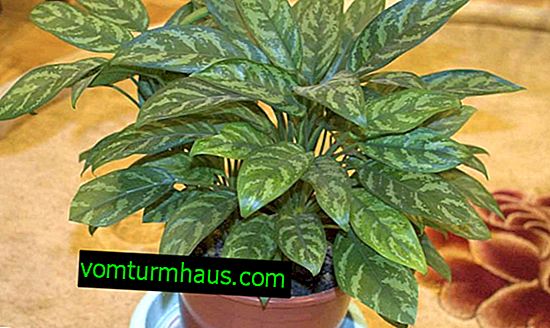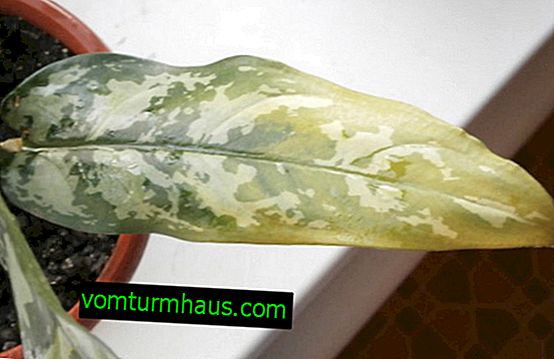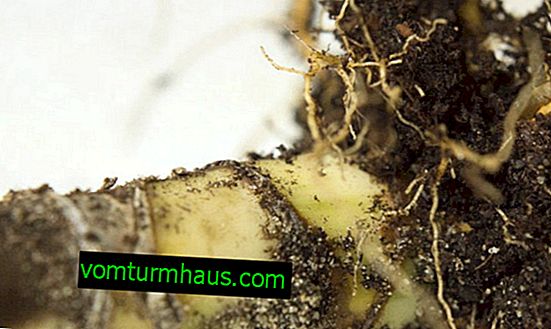Aglaonema Maria: description and care at home
Aglaonema is highly regarded in floriculture due to its decorative qualities - a bright thread-like pattern on a wide emerald green foliage. But depending on external conditions, it can change the brightness and saturation of its hue. All about the types of unique exotics, methods of its reproduction, the intricacies of home care, possible diseases and preventive measures will be discussed later in the article.
Plant description
Aglaonema became famous in the world of botany about half a century ago. For the first time, its low, lush shrubs were found in the Philippine forests, where it is always warm and humid.
Did you know? In the tropics, where the aglaonem comes from, it was long considered a poisonous weed and was widely used to make poison from rodents and insects. The tropical culture is a neat spherical bush up to half a meter high with a nodding lower part of the trunk. The advantage of the plant is the elongated ellipsoidal leaves of a dense emerald color. It is characteristic that the middle of the sheet plates is distinguished by lighter tones, can acquire ashy shades, and the edges are always dark and often painted in abstract order with white lines.

Breeders distinguish several varieties of aglaonema Maria, known among plant lovers as Emerald Beauty or Emerald Beauty. Here are the most popular ones:
- Maria Cristina - differs in large dimensions and grows in height to 70 centimeters;

- Maria Anna - characterized by fine glossy foliage.

Growing conditions
All aglaonems are very demanding of the external environment, so the grower needs to take care in advance of optimal humidity and air temperature for the capricious Emerald beauty.
Important! Withered, yellowed, or faded foliage are clear signs of an aglaonema misplacing. In order not to ruin her, try changing the conditions by rearranging the flower on a sunny windowsill in a warm and humid room.
Since you have to deal with a slowly growing perennial, experienced growers advise:
- in the summer season, twice a week to spray the foliage of the shrub with settled water at room temperature, and in winter, giving the plant peace, limit itself to periodic watering;
- the habit of regularly wiping the leaf plates with a damp cloth will not be superfluous (such a procedure will not only moisten the plant, but also relieve it of dust and pathogenic environment);
- avoid drafts, but at the same time periodically arrange a tropical airing exot (it is better to ensure that there is always fresh air in the room where the flower is located);
- Do not expose the flowerpot to tobacco smoke and cooking fumes (such an environment is considered extremely unfavorable for varieties of aglaonema);
- strictly monitor the temperature in the room (in summer, the optimal indicators are + 20 ... +25 ° C, and in winter - up to + 15 ° C;
- for the location of the flower pot, it is better to choose well-lit areas, because in the dark it poorly develops and loses its decorativeness (it is not necessary to expose the flowerpot under direct sunlight, most importantly, its location should be on the south side).

Home Care
The green aglaonema Maria is ideal for decorating living quarters, offices, lobbies. However, with improper care, very soon, a luxurious shrub with emerald foliage will turn into a yellowing lifeless plant. To prevent this from happening, you need to know the main requirements of the exotic for watering, top dressing, pruning, transplanting, and also propagate it correctly. This is what will be discussed later.
Watering and fertilizing
A flower requires regular moistening of the soil only during the period of active vegetation, which occurs in March and lasts until the fall. In order for the crown of the shrub to always delight with its liveliness and color saturation, it is advisable to moisten the soil in the pot several times a week, without bringing it to swamps or complete drying.
In addition, intermittent showers and regular sprays are very desirable for shrubs. These procedures are the main secret of always brilliant and bright leaves.

In the autumn-winter season, the flower is rarely watered, maintaining the viability of its rhizome. And since all types of aglaonema painfully react to excessive moisture, before each watering, the condition of the upper layer of the substrate in the pot should be diagnosed. Further hydration makes sense only with moderate dryness.
Important! If there is an excess of chlorine in the water for irrigation, spotting or yellowness will soon appear on the leaves of Mary's aglaonema. With dry and wrinkled leaf plates, it is recommended to increase the number of moisturizing procedures for the flowerpot. So that the bush does not lose its emerald shade and neat shape, it should be fed twice a month with mineral complex fertilizers. When choosing preferred compositions with potassium, phosphorus, nitrogen. The amount of solution is prepared in accordance with the recommendations of the manufacturers.

We recommend learning about the features of effective top dressing of indoor plants.
Pruning
If you want a better tillering experience from an exotic culture, don't let it bloom. Experienced flower growers pay attention to the low value of aglaonema inflorescences, as well as to the competition factor in food production. Therefore, in order not to deprive the stems of nutrients, it is recommended to prune flower arrows in a timely manner, not allowing them to blossom. These actions will provoke the appearance of new deciduous buds, which, in turn, will contribute to the growth of the bush.
In addition, experts advise every 3-4 years after the end of vegetative activity to completely cut off all the leaves of the bush at the root. These drastic measures are being taken to renew the crown.
Transfer
Strongly overgrown bushes must be transplanted into large containers. It is best to plan a transplant in early May. The procedure is carried out by dividing the rhizomes. At the same time, it is necessary to cut off young, but strong shoots.

The technology for transplanting any flowerpot is carried out according to the following algorithm:
- Fill the bottom of the pot with small pebbles, broken ceramics or brick fragments (purchased claydite is ideal for drainage).
- Prepare a nutrient substrate from 2 parts of leafy soil, as well as from 1 part of peat and river sand (as an alternative, you can use purchased soils for aroid crops, azaleas and senpolia).
- Fill the pot with prepared soil mixture to a third and water it well.
- Plant a flower in a pot, spreading its roots, and sprinkle with soil on top (make sure that the earth does not cover the plant's growth point, otherwise there are great risks of developing putrid root infections).
- After transplantation, make sure that the flowerpot is in a room where the air temperature is not lower than + 20 ° C.
Breeding
Aglaonema Maria retains its decorative effect for 4–5 years, after which the flowerpot requires radical rejuvenation. Many gardeners are striving to acquire a new seedling by that time. At home, you can get it in several ways.
Dividing the bush
The procedure requires special care and is one of the simplest plant propagation technologies. When you notice young shoots appearing on a growing bush, start dividing. At the beginning of the procedure, carefully pour the flowerpot and, after some time, remove it from the pot along with the earthen tuber.

Cuttings
To obtain a new bush of Mary by cuttings, it will be necessary to prepare several lateral and apical shoots. Their length should correspond to 10-15 cm. Note that only specimens with at least a pair of leaves on the trunk take root.
Important! The fruits of the aglaonema are poisonous. This should be taken into account for those gardeners who have small children and pets in the house.
After collecting the breeding material on the old bush, be sure to treat the places of the cuts with crushed charcoal and let the released juice dry. And it is desirable to treat the cuttings with growth stimulants by dipping their lower part for several hours in aqueous solutions of Emistima, Kornevina, or simply adding baker's yeast or liquid honey to warm water. After the manipulations have been done, it is required to prepare a pot with a light moist substrate and to plant plant blanks. For better survival, you can cover the container with the plant with a plastic bag or a glass vessel. When caring for a young aglaonema, do not forget to air your seedlings daily. New plants take root after 4 weeks.
Video: Rooting cuttings
Seeds
This method is more suitable for lovers of breeding work. It is time consuming and requires a lot of patience. But if, nevertheless, you risk getting the Emerald Beauty from seeds, you will have to leave Mary's flowering inflorescences and wait until the fruits ripen from them. It is possible to collect the seed when the berries that are filled with bright red will be easily separated from the cob. Grains are hidden inside their pulp. After removal, they should be thoroughly washed and dried. And only then you can sow. This is done in the traditional way. To improve germination, experienced growers cover the container with glass or polyethylene.
When propagating a flower by seed, be prepared for the slow growth of seedlings. Maria compensates for this shortcoming by simultaneously receiving a large amount of planting material. Just keep in mind that aglaonema grains are poorly stored, so it is recommended that they be sown immediately after collection.

Diseases, pests and methods of dealing with them
The appearance of the shrub at first glance will tell a lot about the conditions of its cultivation and care. And all because even the smallest mistakes of the grower affect the color of the leaves and the splendor of the crown. Let us analyze the common problems experienced by gardeners:
- Brown spotting on the foliage and stunting is a sign of low water temperatures, which is used for irrigation. And also these phenomena may indicate excessive water hardness. The problem can be solved by boiling and daily settling of the liquid, as well as by adding lemon juice to it.
- Curled dry edges on the leaves indicate excessive dryness of the air in the room. You can fix the problem by arranging a tropical exotics of showers (water should be at room temperature) and regular spraying of the crown.

- Yellowing foliage indicates excessive watering or low air temperatures in the room where the flowerpot grows. In this situation, it is necessary to immediately bring the conditions in line with the requirements of a tropical culture.
- Withered, deformed leaves appear when pests attack the plant. Among the most dangerous for the aglaonema are thrips, whiteflies, aphids, spider mites, scale insects, mealy worms. Monitor the condition of the shrub and regularly inspect its crown for harmful insects. If they are detected, insecticidal preparations will come to the rescue: Aktara, Aktellik, Biotlin, Bankol, Fitoverm, Calypso.
- Appeared orange convex pads on the underside of the sheets and golden spots on the top indicate the development of a fungal disease. Rust can be removed from the bush with the fungicide "Skor", as well as pollinating the affected areas of the plant with ground sulfur.
- Rotten stems, the drooping state of a flower and the lack of its development are clear signs of putrefactive infections that can spread to both the underground and aboveground parts of the flowerpot. In such circumstances, it is recommended to minimize the amount of watering, to increase ventilation, increase the temperature in the room and eliminate the damaged areas of the plant. In advanced cases, it will be effective to treat the crown and water the roots with 0.2% Fundazole solution. Repeated use of the drug will be relevant after a week and a half.

- When a thin soot film appeared on the leaves, urgent measures are required to save the exot from the soot fungus. This disease develops on the traces of vital activity of aphids, clogging leafy pores and obstructing the processes of photosynthesis. First you need to treat the bush with any insecticide, and then remove plaque from the leaves. Then it is advisable to rinse the flower in warm water.







